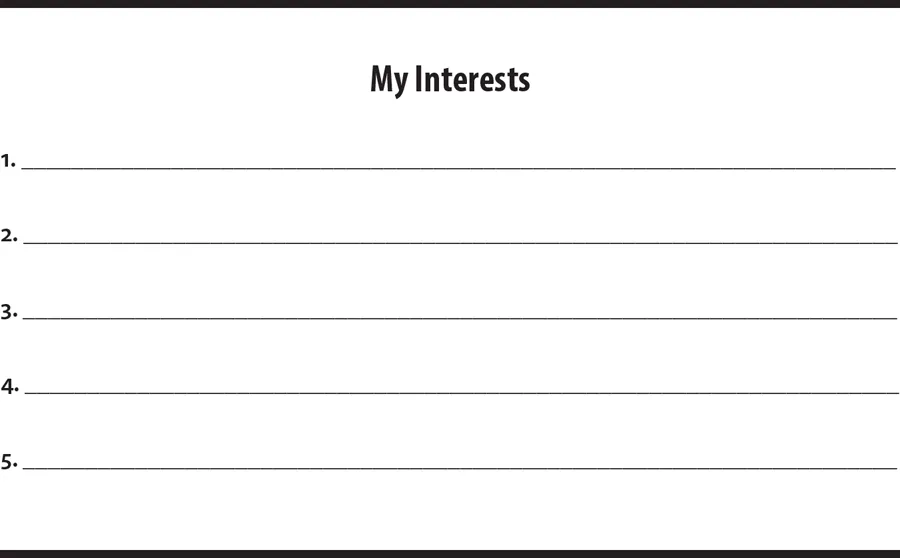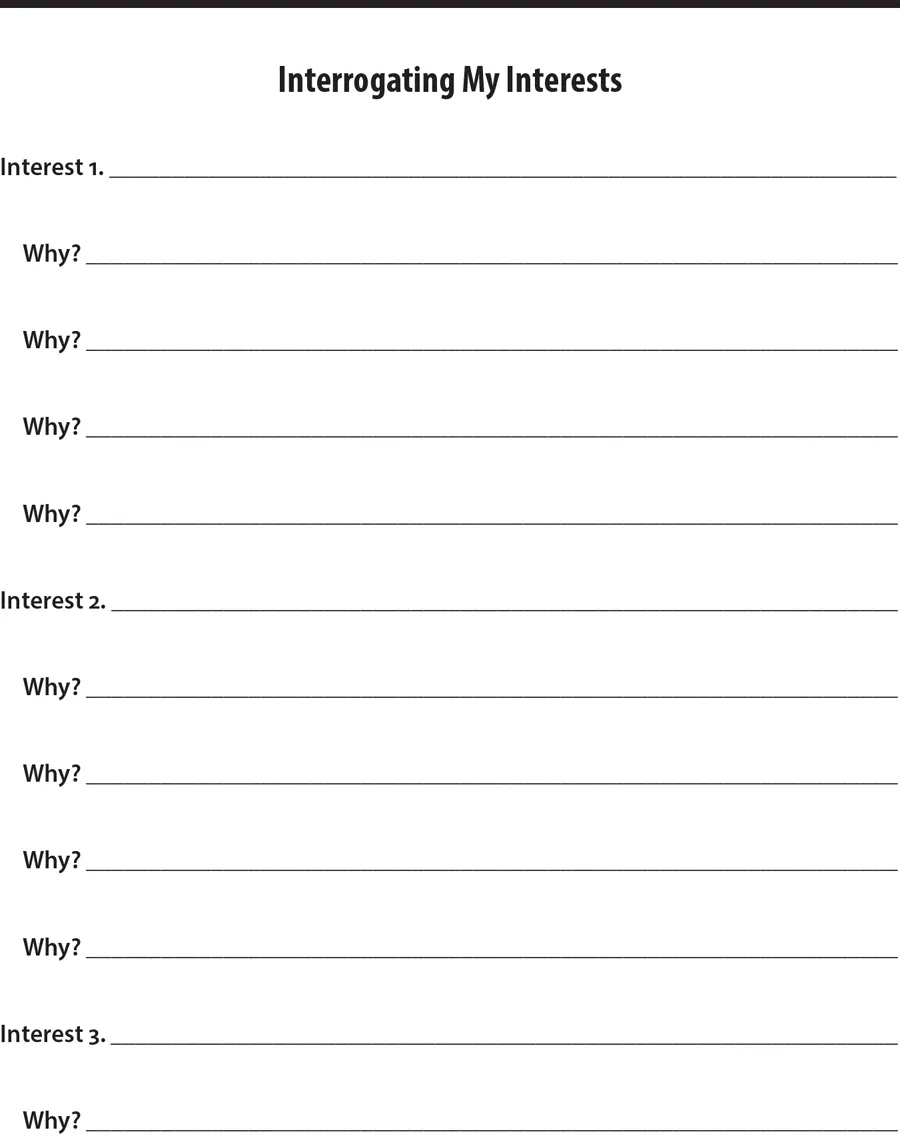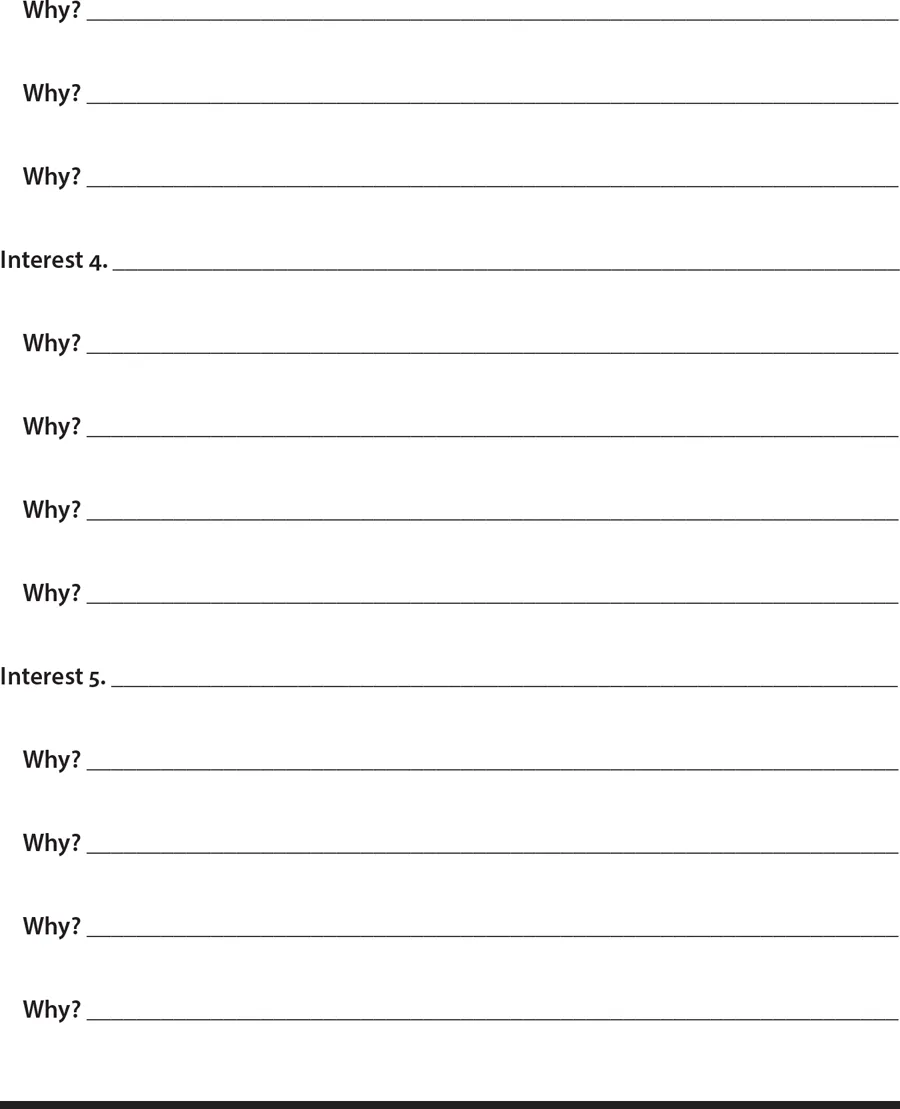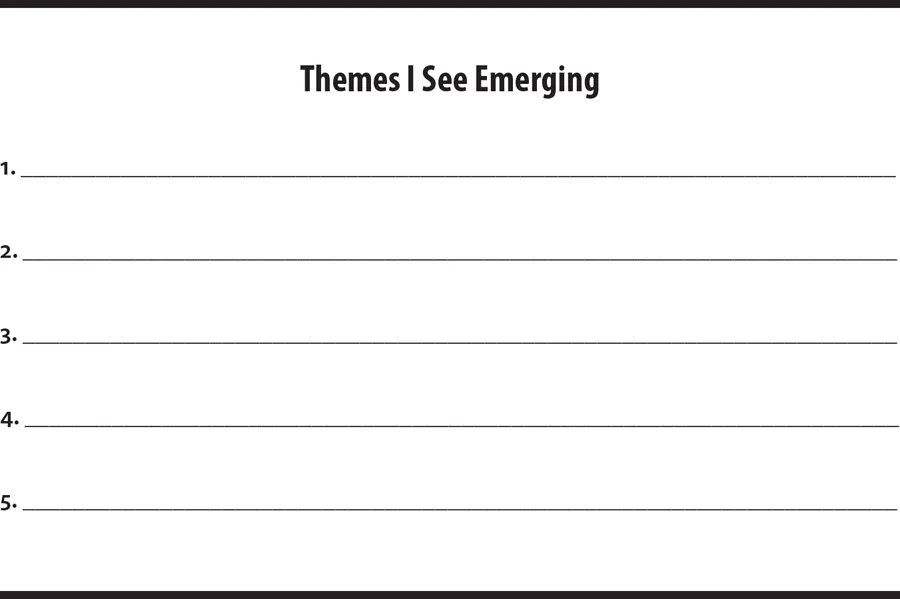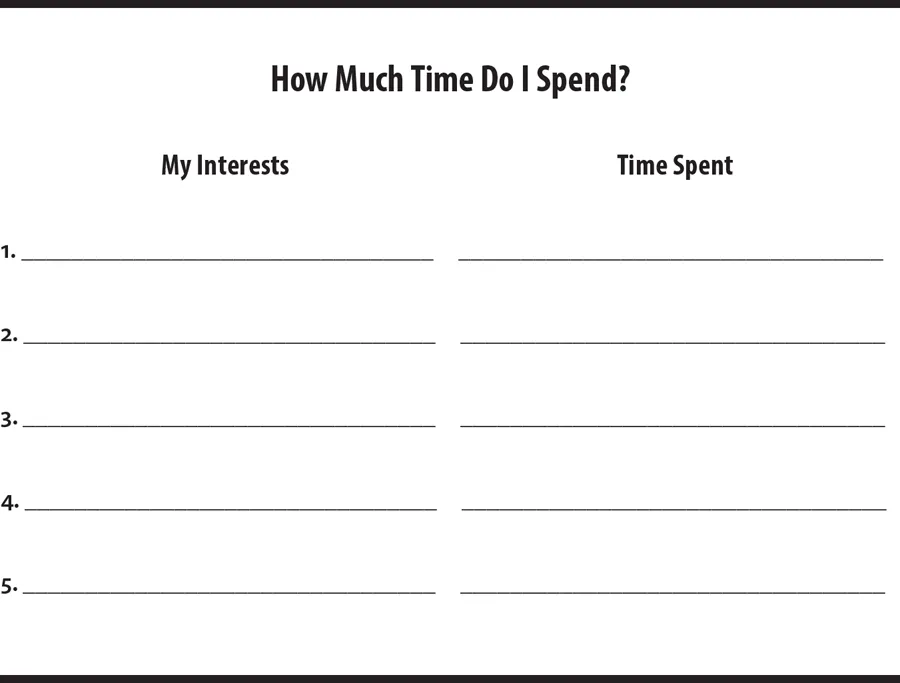![]()
Part I
Self
A Review of Those Aspects of Your Life That Make You Who You Are
![]()
Chapter 1
Interests
The purpose of the work to be completed in this chapter is to arrive at a point where you, the reader, better understand those things in your life that are attractive to you, are motivational, are inspirational, and make you feel good.
Let’s start our journey with something easy and perhaps fun for many readers. Let’s talk about what your interests are and why they are your interests.
First, let’s define here what we mean by your interests. Interests are those aspects of an individual’s life to which he or she is attracted. Interests may provide an outlet for creativity or a way to reduce stress, be a contributor to one’s inspiration, or perhaps act as a path to feeling relaxed or happier. A casual interest is an intrinsically rewarding, short-lived, pleasurable activity requiring little or no preparation, such as having an interest in going to the movies for fun. If you feel like going to the movies, you can check the local theater for times, pick a film that sounds interesting in the moment, and go. A serious interest is the systematic pursuit of a hobby, a sport, or a volunteer activity that is a substantial time investment, provides greater rewards and satisfaction, and results in a sense of accomplishment or good feeling. To take the film example further, someone with a serious interest in film might go to the movies regularly, read film magazines, attend film festivals to search out obscure auteurs, and write reviews for a movie blog or local newspaper.
Pleasurable activity can take place in different settings. For example, you can have interest in activities you do when you’re not working (e.g., travel to new places), when you’re working (e.g., leading a team), when you’re learning (e.g., obtaining a postgraduate degree), or, perhaps, when serving your country (e.g., military reserve or guard duty). Only you can determine what your casual and serious interests are and what their impact is on your life and well-being.
Here are some common interests that people have to help you think about what your interests might be:
■ Reading books
■ Meditation
■ Spending quality time with family
■ Spending time with pets or other animals
■ Visiting parks and nature
■ Music—listening to or creating
■ Collecting—stamps, music, coins, etc.
■ Playing or watching sports
■ Watching movies
■ Touring museums
■ Creating art
■ Eating out
■ Cooking
■ Exploring other cultures
■ Traveling
■ Photography
■ Physical activity/exercise
■ Contributing to charities
■ Having lunch at work with associates
■ Joining work or social clubs
■ Taking classes or seeking a degree
■ Relaxing at the beach
■ Gardening
■ Mentoring
Take some time for the following exercise: Make a list of at least five things in your life that are of keen interest to you. Think broadly. Whatever they are, list them.
Here are a few examples of responses from individuals we have coached:
When Linda was asked about her interests, she said her primary interest was travel. We asked, “Why?” She responded that she liked to visit new places. Again, “Why?” She said it helped her to learn about other people and cultures. We continued to probe: “Why is that important?” She said that it allowed her to remove herself from her own people and culture, relaxed her, was educational, and made her feel freer from whatever she left back home. So, for Linda, traveling was an exercise in freedom, relaxation, and education—a balm or salve for her very busy life.
John said that his primary interests included playing golf and going out for drinks and dinner with friends. Why? He said that golf, although individually challenging, represented a way for him to be with and bond with other men in a shared experience. We asked why that was important to him. He responded that he was single, lived alone, and enjoyed the company of other people, whether at play or at work. Why? He noted that it provided a sense of being on a team or in a family. Why? What meaning did that have for him? He said that doing things with others and not being alone all the time was important to him. So John wanted companionship, friendship, and a sense of belonging, not just a golf game and a few drinks.
After you have filled in your own five interests, let’s try to discern just why these five things are of interest to you. To do that, ask yourself that same simple question for each one of your stated interests. Why is this particular thing of interest to me? After you have answered that question, keep asking “Why?” again three or four times, to get deeper and deeper into your motivations for being attracted to that particular thing. This questioning method will help you to get at the real reason this activity is of interest to you. It is important that you think through all of these interests, since the work you do now will tie in later to other parts of the Life & Career Planning Model and will help you to better understand your needs and desires, in both your private life and your career. As with all parts of the model, you need to write down your responses for future reference and for when we blend all the parts of the model into your vision and action plan for the future later in the process. It is very important to document your responses to each part of the model. You will need to refer back to this documentation when developing your action plan now, as well as when you need to update your plan when something in your life situation changes.
Now that you know the process, transfer the five interests you wrote down above to the box below and interrogate each one a few times until you uncover the importance of your interests to your life.
When you review your responses, noting why you have these interests, do you see any themes emerging? If so, what are they? Write them down in the box on the following page. In the preceding examples, the themes that emerged for Linda were the excitement provided by learning in different cultures, becoming unattached from her familiar setting and life’s stresses, and having a feeling of personal freedom. For John, although his focus is a sport, golf, the key themes in his interest are his need for having close ties to others in a friendly environment and to overcome the feeling of loneliness in his life by connecting with other people. So what are the themes emerging in your interests?
The surest path to true happiness lies in chasing not just happiness but also a meaningful life.
—Emily Esfahani Smith and Jennifer Aaker, “In 2017, Pursue Meaning Instead of Happiness”
Are some of the themes found across most of your interest areas? For example, do your interest areas excite you, calm you down, make you feel stronger, get you intellectually more curious, arouse your senses, solidify relationships, or just feed your curiosity? These factors are at the core of what motivates you toward these various activities. Later we can explore them from the point of view of the work you like to do, the people you like to associate with, and the life you would like to lead.
At this point, when looking at what you have written, make sure that you have not overlooked any interests of importance to you. If you have, go back and add them to your list. Then we can move on.
Next, think about the amount of time you spend engaged in the interests that you enjoy and document that below. It is okay to use estimates. We all have different amounts of time to spend at work and at home. Some of that time is spent with family and friends, some on chores, and some on one or more of our interests.
Then, consider what activities you spend time on that are not key interests. These would be activities that are necessary for the functioning of your life but perhaps bring you little pleasure. List at least five of those, for example, talking with friends on the phone, watching television, going to the gym, volunteering, spending time on social media, shopping, reading, sleeping late, managing personal assets, cooking, and doing housework. Alex goes to the gym three or four times a week because he wants to stay healthy. However, there are some mornings that he has to drag himself out of bed to get there—not very pleasurable. But he needs it in his life, so he goes. Melissa, on the other hand, is a gym rat and belongs to a boot camp, which she happily and regularly attends. She likes it so much that she has received several awards for fitness and boxing. See the difference? For Melissa, going to the gym is a major interest; for Alex, it’s something he feels he has to do but is not among his major interests.
Some people, especially in this age of social media, spend a significant amount of time on their electronic devices. Recent research indicates that there are those who almost have an addiction to the use of these technologies.1 Their use can certainly be distracting. If you’re in a relationship and your significant other has to say to you, “Please put down the phone; you are here, but you are not here,” you may have to consider how your use of technology is impacting your personal life. This particular interest could create some dysfunction in your life and may need to be better controlled.
Why do you spend time on these activities? Is it habit? Doing it for someone else? People expect it of you? Are there clear reasons for you to engage in this activity? If not, would it be easy or difficult to disengage? Document your responses for each activity.
For example, James volunteers for a nonprofit organization. When asked why, he said he wanted to give back to his community. When asked if he enjoyed volunteering for this organization, he said, “Not really.” When asked why he felt that way, he said that the time he was spending helping this social service organization was not exceptionally fulfilling. When asked why it wasn’t fulfilling, he said the volunteering was in an area in which he had little interest, but the volunteer work was easy. When asked what he might be interested in instead, he said he was very interested in the creative arts. From there we began to talk about what it might take for him to stop volunteering in the social services organization and to find a way to volunteer for a creative arts organization. In other words, some people migrate down the road that’s easiest to walk down rather than focusing on the path that will help them to arrive at a place more suited to their real interests and therefore more appealing. By interrogating why you are participating in activities that do not revolve around your core interests, you may uncover some surprising insight...


